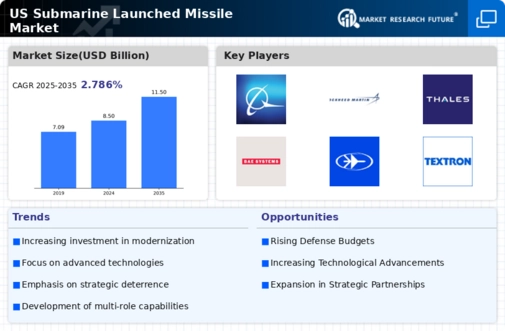Rising Geopolitical Tensions
The submarine launched-missile market is experiencing growth due to escalating geopolitical tensions, particularly in regions such as the Asia-Pacific. Nations are increasingly investing in advanced military capabilities to deter potential threats. The U.S. government has allocated approximately $750 billion for defense spending in 2025, with a significant portion directed towards enhancing naval capabilities. This trend indicates a robust demand for submarine launched missiles, as they provide strategic advantages in deterrence and power projection. The focus on maintaining a technological edge over adversaries further propels investments in this sector, suggesting that the submarine launched-missile market will continue to expand as nations seek to bolster their defense postures.
Advancements in Missile Technology
Technological innovations are a key driver in the submarine launched-missile market. Recent developments in missile guidance systems, propulsion technologies, and warhead capabilities have enhanced the effectiveness and reliability of these systems. For instance, the introduction of hypersonic missiles is reshaping strategic military planning, as they can evade traditional defense systems. The U.S. Navy's investment in next-generation missile systems, estimated at $20 billion over the next decade, underscores the importance of technological advancements in maintaining operational superiority. As these technologies evolve, they are likely to attract further investment, thereby stimulating growth in the submarine launched-missile market.
International Defense Collaborations
Collaborative defense initiatives among allied nations are influencing the submarine launched-missile market. The U.S. has engaged in various partnerships aimed at enhancing collective security and interoperability among allied forces. These collaborations often involve joint development and procurement of advanced missile systems, which can lead to increased demand in the submarine launched-missile market. For instance, the AUKUS pact between the U.S., UK, and Australia emphasizes the sharing of advanced military technologies, including submarine capabilities. Such international partnerships not only strengthen defense ties but also create opportunities for market growth, as allied nations seek to enhance their submarine launched missile capabilities.
Strategic Naval Modernization Programs
The ongoing modernization of naval fleets is significantly impacting the submarine launched-missile market. The U.S. Navy is actively upgrading its submarine fleet, with plans to integrate advanced missile systems into new and existing vessels. This modernization effort is part of a broader strategy to enhance maritime security and deterrence capabilities. The Congressional Budget Office projects that the U.S. will spend over $100 billion on submarine procurement and modernization through 2030. Such investments not only improve the operational capabilities of submarines but also drive demand for advanced missile systems, indicating a positive outlook for the submarine launched-missile market.
Increased Focus on Deterrence Strategies
The submarine launched-missile market is being propelled by a heightened emphasis on deterrence strategies among military planners. As nations perceive rising threats from regional adversaries, there is a growing recognition of the need for credible deterrent capabilities. Submarine launched missiles offer a stealthy and survivable means of delivering nuclear and conventional payloads, making them a cornerstone of modern deterrence strategies. The U.S. Department of Defense has indicated that maintaining a robust sea-based deterrent is essential for national security, which could lead to increased procurement of submarine launched missiles. This strategic focus suggests a sustained demand for these systems in the coming years.




















Leave a Comment